Do you have a question about the Trane TZONE950AC52ZA and is the answer not in the manual?
Warning about live electrical components during installation, testing, servicing, and troubleshooting.
Description of the ComfortLink II Thermostat as a communicating 7-inch color touch screen.
Lists the parts included in the product model TZONE950AC52ZA.
Provides detailed technical specifications for the ComfortLink II Thermostat.
Diagram illustrating system connections for a communicating thermostat and indoor/outdoor units.
Diagram illustrating system connections for a 24V thermostat and relay panel with indoor/outdoor units.
Recommendations for optimal thermostat sensor placement in climate-controlled living spaces.
Guidance on mounting locations to ensure adequate wireless signal strength and avoid interference.
Instructions for detaching the thermostat sub-base wall plate using a screwdriver.
Steps for securely mounting the thermostat sub-base to wall studs using provided screws.
Instructions for mounting the thermostat sub-base to drywall using SnapSkru® connectors.
Critical warnings about live electrical components and equipment damage due to improper wiring.
Information on power connections and step-by-step wire connection instructions.
Instructions for re-attaching the thermostat unit to its sub-base after wiring.
Wiring diagram for connecting the thermostat in a communicating system configuration.
Wiring diagram for systems with a communicating indoor unit and non-communicating outdoor unit.
Wiring diagram for connecting the thermostat in a 24V system configuration using a relay panel.
Description of the power-up process for both communicating and 24V equipment setups.
Overview of the home screen and basic navigation through menus and buttons.
Navigating to service menus, dealer information, and technician access screens.
Overview of the Service Menu options including Installer Setup and Diagnostics.
Options for operating modes including Standard, Advanced, and Restore Defaults.
Manual selection and configuration of basic equipment components for non-communicating systems.
Fine-tuning system operation and configuring installed accessories and comfort options.
Enabling or disabling comfort settings like dehumidification.
Restores the thermostat to factory default settings, erasing all configurations.
Resets advanced setup selections like lockouts, accessories, and comfort options to defaults.
Allows immediate setpoint changes for Home, Away, and Sleep modes.
Option to disable the 10-minute inhibit for faster temperature recovery in heating/cooling.
Configuration options for the air cleaner operation (Auto, Quick Clean, Allergy Clean).
How system alerts are displayed on the home screen and their meaning.
Control over screen backlight behavior, timeout periods, and brightness.
Setting independent blower delays for heating and cooling modes.
Calibrating indoor and outdoor sensors for temperature and humidity.
Adjusting thermostat response rate and personalizing the home screen.
Affects system cycle time and on/off intervals based on load values.
Entering dealer contact details, address, and optional logo for the thermostat.
Configuration and operation of the dehumidification feature, including airflow reduction and overcooling.
Smart Continuous Fan operation interrupted by high humidity conditions.
Viewing current alerts, alert history, problem descriptions, and possible causes.
Setting system changeover from heat pump to furnace based on comfort, cost, or temperature.
Enabling furnace/heat strips when the thermostat is set to Emergency Heat.
Listing model and serial numbers for communicating and non-communicating components.
Options for blower operation: Auto, On, or Circulate mode.
Accessing help information via the Help icon on various screens.
Viewing system run time history compared to indoor/outdoor temperatures weekly or monthly.
Viewing system cycle information, counts, and run time over 24 hours, 1 week, or 2 weeks.
Setting indoor RH setpoint, frost control, and control options for humidification.
Categories for Installer Setup: Standard basic settings and Advanced for fine-tuning.
Numerical representation of needed capacity to satisfy the setpoint.
Disabling system functions based on specific outdoor temperature thresholds.
Linking multiple thermostats to control individual systems via a wireless network.
Customizing the screen saver with photos via an SD card.
Setting service reminders for filters, UV lamps, humidifier pads, etc.
Options to restore settings: Setting Screen, Advanced Options, or Equipment Defaults.
Provides system run time information relative to indoor and outdoor temperatures.
Setting 7-day programming with daily time periods, options for Guided or Manual Setup.
Creates a 30-second screen lockout for cleaning without changing settings.
Allows customization of what is displayed on the home screen.
Logging all thermostat information to an SD Card, overwriting oldest data.
Initiates keypad lockout with Pin Lock or Guest mode for access control.
Sets the temperature band between heating and cooling setpoints in auto mode.
Field software upgradable via SD card insertion and update initiation.
Prevents the next stage of capacity from initializing if current stage satisfies the load.
Provides real-time, in-depth look at operating conditions for service technicians.
Snapshot of system operation including mode, airflow, and reminders.
Locks the system into a particular mode of operation for up to 30 minutes.
Accessing technician service screens after a 5-second hold delay.
Setting vacation periods with specific dates, times, and temperatures for setback.
Reduces variable speed blower airflow by 20% during compressor heating.
Displays outdoor temperature, 5-day forecast, and local Doppler radar via wireless connection.
Troubleshooting alert codes displayed on the thermostat screen.
Troubleshooting steps when the thermostat display remains blank.
Troubleshooting incorrect indoor temperature readings, including calibration.
Troubleshooting incorrect indoor humidity readings, including calibration.
Addressing temperature overshooting issues related to equipment or thermostat placement.
Troubleshooting common causes for heating system failure to activate.
Troubleshooting common causes for cooling system failure to activate.
Diagnosing issues when heating or cooling is active but no air is delivered.
Troubleshooting the fan running continuously when it should not.
Troubleshooting the fan not running when it is set to ON.
Addressing temperature swings caused by improper cycle rates or recovery settings.
Troubleshooting heat pump activation issues, focusing on furnace/strip heat operation.
Resolving issues where the system mode cannot be changed to the desired setting.
Troubleshooting unresponsive screen buttons, including calibration.
Troubleshooting internal errors causing 'No System Found' on the thermostat.
Troubleshooting slow or no response from any button presses.
Standard parameters including outdoor unit type, stages, compressor type, and indoor unit details.
Advanced equipment settings for compressors, heating cycles, and minimum on times.
Configuration and calibration settings for outdoor and indoor temperature sensors.
Settings for filtration type, air cleaners, humidifiers, UV lights, and ERV.
Comfort settings including dehumidification, response rate, and aggressive recovery.
Setting for reducing blower airflow during compressor heating operation.
Configuration of variable and non-variable speed blower on/off delays and airflow percentages.
Configuring lockouts for compressor heating, auxiliary heat, and defrost stages based on temperature.
| Type | Thermostat |
|---|---|
| Model Number | TZONE950AC52ZA |
| Control Type | Touchscreen |
| Display | Color Touchscreen |
| Wi-Fi Enabled | Yes |
| Programmable | Yes |
| Humidity Control | Yes |
| Remote Access | Yes |
| Energy Monitoring | Yes |
| Voice Control | Amazon Alexa, Google Assistant |
| Power Source | 24V AC |
| Product Type | Thermostat |
| Compatibility | Compatible with Trane HVAC systems |
| Mobile App | Trane Home |
| Stages | 2 Heat / 2 Cool |
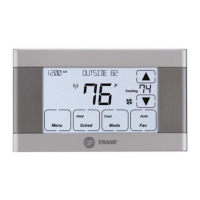
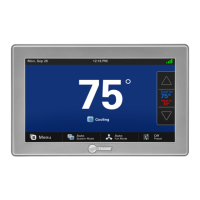
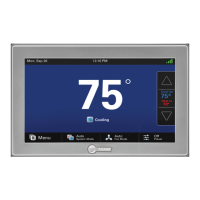


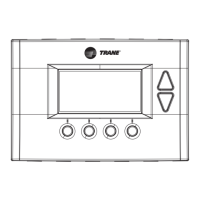

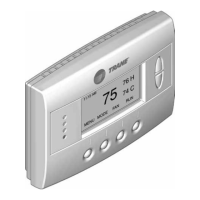
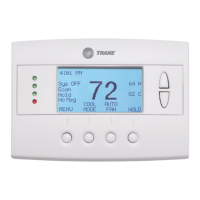
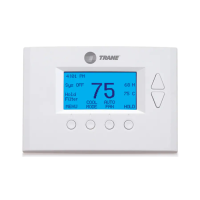
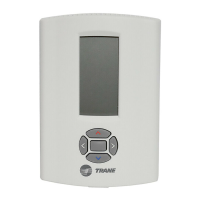
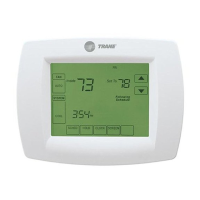
